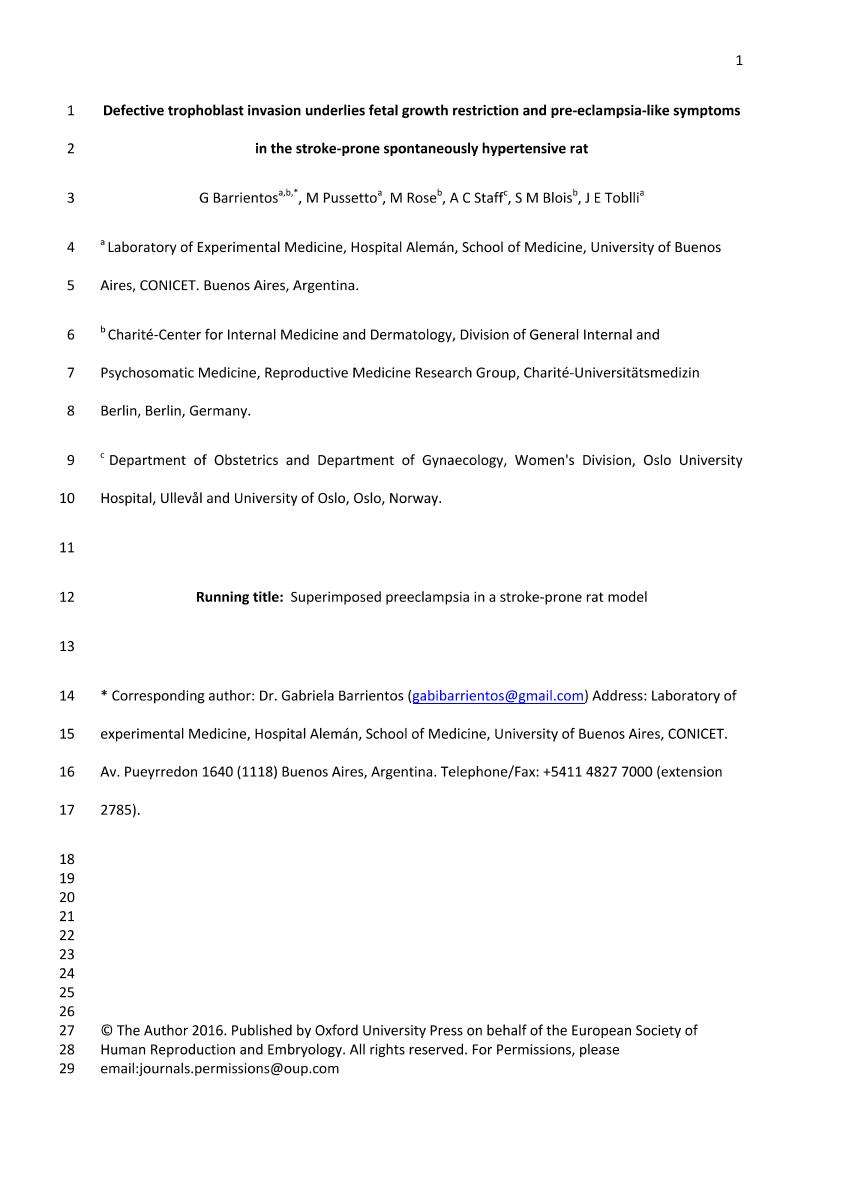Mostrar el registro sencillo del ítem
dc.contributor.author
Barrientos, G.
dc.contributor.author
Pussetto, M.
dc.contributor.author
Rose, M.
dc.contributor.author
Staff, A. C.
dc.contributor.author
Blois, S.M.
dc.contributor.author
Toblli, Jorge Eduardo

dc.date.available
2018-04-11T21:11:56Z
dc.date.issued
2017-04
dc.identifier.citation
Barrientos, G.; Pussetto, M.; Rose, M.; Staff, A. C.; Blois, S.M.; et al.; Defective trophoblast invasion underlies fetal growth restriction and pre-eclampsia-like symptoms in the stroke-prone spontaneously hypertensive rat; Oxford University Press; Molecular Human Reproduction; 23; 7; 4-2017; 509–519
dc.identifier.issn
1360-9947
dc.identifier.uri
http://hdl.handle.net/11336/41815
dc.description.abstract
STUDY QUESTION
What is the impact of chronic hypertension on placental development, fetal growth and maternal outcome in the stroke-prone spontaneously hypertensive rat (SHRSP)?
SUMMARY ANSWER
SHRSP showed an impaired remodeling of the spiral arteries and abnormal pattern of trophoblast invasion during placentation, which were associated with subsequent maternal glomerular injury and increased baseline hypertension as well as placental insufficiency and asymmetric fetal growth restriction (FGR).
WHAT IS KNOWN ALREADY
A hallmark in the pathogenesis of preeclampsia (PE) is abnormal placentation with defective remodeling of the spiral arteries preceding the onset of the maternal syndrome. Pregnancies affected by chronic hypertension display an increased risk for PE, often associated with poor maternal and fetal outcomes. However, the impact of chronic hypertension on the placentation process as well as the nature of the factors promoting the development of PE in pregnant hypertensive women remain elusive.
STUDY DESIGN, SIZE, DURATION
Timed pregnancies [n = 5] were established by mating 10–12-week-old SHRSP and Wistar Kyoto (WKY, normotensive controls) females with congenic males. Maternal systolic blood pressures (SBPs) were recorded pre-mating, throughout pregnancy (GD1–19) and post-partum by the tail-cuff method. On selected dates, 24 h urine- and blood samples were collected, and animals were euthanized for isolation of implantation sites and kidneys for morphometrical analyses.
PARTICIPANTS/MATERIALS, SETTING, METHODS
The 24 h proteinuria and the albumin:creatinine ratio were used for evaluation of maternal renal function. Renal injury was assessed on periodic acid Schiff, Masson's trichrome and Sirius red stainings. Placental and fetal weights were recorded on gestation day (GD)18 and GD20, followed by determination of fetal cephalization indexes and developmental stage, according to the Witschi scale. Morphometric analyses of placental development were conducted on hematoxylin-eosin stained tissue sections collected on GD14 and GD18, and complemented with immunohistochemical evaluation of isolectin B4 binding for assessment of placental vascularization. Analyses of vascular wall alpha actin content, perforin-positive natural killer (NK) cells and cytokeratin expression by immunohistochemistry were used for evaluation of spiral artery remodeling and trophoblast invasion.
MAIN RESULTS AND THE ROLE OF CHANCE
SHRSP females presented significantly increased SBP records from GD13 to GD17 (SBPGD13 = 183.9 ± 3.9 mmHg, P < 0.005 versus baseline) and increased proteinuria at GD18 (P < 0.01 versus WKY). Histological examination of GD18 kidneys revealed glomerular enlargement and mesangial matrix expansion, which were not evident in pregnant WKY or age-matched virgin SHRSP. At GD20, SHRSP displayed a significant reduction of placental mass (P < 0.01 versus WKY) and signs of placental insufficiency (i.e. hypertrophy and reduced branching morphogenesis of the labyrinth layer), associated with decreased offspring weights and increased cephalization index (both P < 0.001 versus WKY) indicating asymmetric FGR. Notably, SHRSP placentas displayed an incomplete remodeling of spiral arteries starting as early as GD14, with luminal narrowing and reduced densities of perivascular NK cells followed by decreased infiltration of endovascular trophoblasts at GD18.
LARGE SCALE DATA
n/a.
LIMITATIONS, REASONS FOR CAUTION
A pitfall of the present study is the differences in the blood pressure profiles between rats and humans (i.e. unlike pregnancies affected by PE, blood pressure in SHRSP and other hypertensive rat models decreases pre-delivery), which limits extrapolation of the results.
WIDER IMPLICATIONS OF THE FINDINGS
Our findings provide new insights on the role of chronic hypertension as a risk factor for PE by interfering with early events during the placentation process. The SHRSP strain represents an attractive model for further studies aimed at addressing the relative contribution of intrinsic (i.e. placental) and extrinsic (i.e. decidual/vascular) factors to defective spiral artery remodeling in pregnancies affected by PE.
STUDY FUNDING AND COMPETING INTEREST(S)
This work was supported by research grants from Fundación Florencio Fiorini to G.B., from Charité Stiftung to S.M.B. and University of Buenos Aires (UBACyt) to J.T. The authors have no competing interests to declare.
dc.format
application/pdf
dc.language.iso
eng
dc.publisher
Oxford University Press

dc.rights
info:eu-repo/semantics/openAccess
dc.rights.uri
https://creativecommons.org/licenses/by-nc-sa/2.5/ar/
dc.subject
Animal Model
dc.subject
Hypertension
dc.subject
Placental Insufficiency
dc.subject
Pre-Eclampsia
dc.subject
Vascular Remodeling
dc.subject.classification
Inmunología

dc.subject.classification
Medicina Básica

dc.subject.classification
CIENCIAS MÉDICAS Y DE LA SALUD

dc.title
Defective trophoblast invasion underlies fetal growth restriction and pre-eclampsia-like symptoms in the stroke-prone spontaneously hypertensive rat
dc.type
info:eu-repo/semantics/article
dc.type
info:ar-repo/semantics/artículo
dc.type
info:eu-repo/semantics/publishedVersion
dc.date.updated
2018-04-10T20:29:25Z
dc.journal.volume
23
dc.journal.number
7
dc.journal.pagination
509–519
dc.journal.pais
Reino Unido

dc.journal.ciudad
Oxford
dc.description.fil
Fil: Barrientos, G.. Hospital Alemán. Laboratorio de Medicina Experimental; Argentina
dc.description.fil
Fil: Pussetto, M.. Hospital Alemán. Laboratorio de Medicina Experimental; Argentina
dc.description.fil
Fil: Rose, M.. Charité-center For Internal Medicine And Dermatology, D; Alemania
dc.description.fil
Fil: Staff, A. C.. Department Of Obstetrics And Department Of Gynaecology,; Noruega
dc.description.fil
Fil: Blois, S.M.. Charité-center For Internal Medicine And Dermatology, D; Alemania
dc.description.fil
Fil: Toblli, Jorge Eduardo. Universidad de Buenos Aires; Argentina. Hospital Alemán. Laboratorio de Medicina Experimental; Argentina. Consejo Nacional de Investigaciones Científicas y Técnicas. Oficina de Coordinación Administrativa Houssay. Instituto de Investigaciones Cardiológicas. Universidad de Buenos Aires. Facultad de Medicina. Instituto de Investigaciones Cardiológicas; Argentina
dc.journal.title
Molecular Human Reproduction

dc.relation.alternativeid
info:eu-repo/semantics/altIdentifier/url/https://academic.oup.com/molehr/article-abstract/23/7/509/3574876
dc.relation.alternativeid
info:eu-repo/semantics/altIdentifier/doi/http://dx.doi.org/10.1093/molehr/gax024
Archivos asociados
